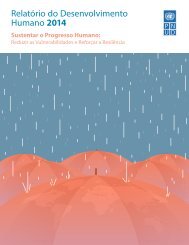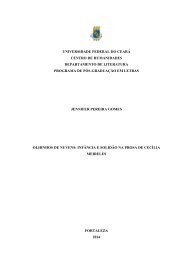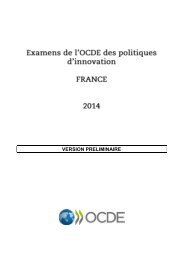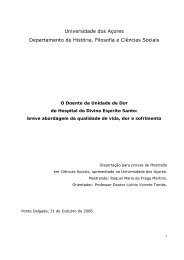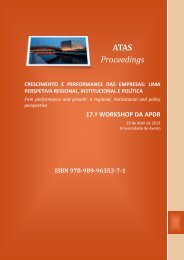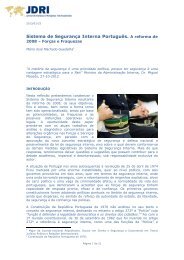1POTXAdSn
1POTXAdSn
1POTXAdSn
Create successful ePaper yourself
Turn your PDF publications into a flip-book with our unique Google optimized e-Paper software.
laridade. Embora possa ser considerada uma baixa riqueza<br />
específica, quando comparada com as de outros<br />
arquipélagos oceânicos, é inegável o seu interesse histórico<br />
e evolutivo. A origem vulcânica confere às ilhas<br />
declives abruptos que se precipitam quase verticalmente<br />
para profundidades abissais, limitando assim a faixa<br />
batimétrica de baixa profundidade, tornando a disponibilidade<br />
de espaço um factor determinante para a diversidade<br />
biológica. É um facto que o perímetro das<br />
ilhas confere uma longa linha de costa ao arquipélago,<br />
mas o declive marcado limita o espaço disponível, condicionando<br />
a produtividade biológica e conferindo aos<br />
habitats marinhos costeiros destas ilhas oceânicas uma<br />
fragilidade inexistente em ilhas da plataforma continental.<br />
Assim, a exiguidade da faixa costeira acima dos<br />
50 metros implica uma concentração das espécies num<br />
espaço reduzido, factor de extrema importância a ter<br />
em consideração quando é necessário ponderar a fragilidade<br />
do ecossistema em decisões de gestão costeira.<br />
Os primeiros registos da fauna marinha dos Açores<br />
remontam às crónicas quinhentistas de Gaspar Frutuoso<br />
e à colonização humana das ilhas. As primeiras<br />
publicações de cariz científico datam dos finais do século<br />
XIX, feitas por naturalistas como Drouët (1861)<br />
e Barrois (1888). As colecções do príncipe Alberto do<br />
Mónaco, obtidas nas expedições aos Açores em 1886,<br />
1887, 1888, 1904 e 1913, apresentam também uma importância<br />
considerável. Trabalhos recentes têm contribuído<br />
para o conhecimento de alguns grupos menos<br />
conhecidos (ex. Pycnogonida e Tanaidacea) ao aumentar<br />
o número de registos no arquipélago e descrevendo<br />
novos endemismos (ex. Bamber & Costa 2009), mas<br />
evidenciando ao mesmo tempo as falhas ainda existentes<br />
na inventariação da fauna deste arquipélago.<br />
A relação próxima entre a fauna de invertebrados marinhos<br />
locais e a do Mediterrâneo, seguida de uma proximidade<br />
com a da costa portuguesa e com a das Ilhas<br />
Britânicas, é referida por vários autores (ex. Boury-Esnault<br />
& Lopes 1985; Lopes et al. 1993; Ávila 2005). No<br />
entanto, alguns taxa (ex. Hydrozoa, Pycnogonida) parecem<br />
favorecer a hipótese de uma via de colonização<br />
de oeste, dadas algumas afinidades encontradas com as<br />
Caraíbas e a costa continental americana.<br />
O número dos taxa de invertebrados marinhos, a<br />
extensão da costa açoriana, a literatura dispersa e antiga,<br />
com sinonímias ultrapassadas e tendências geográ-<br />
292<br />
of the low species’ richness of the Azorean fauna, when<br />
compared with other archipelagos, its evolutionary and<br />
historical relevance are unquestionable. The volcanic<br />
origin in the middle of the open ocean resulted on<br />
steep sloping shores that plunge almost vertically<br />
into abyssal depths, narrowing the shallow water<br />
fringe and making space availability a determinant<br />
factor for biological diversity. The islands’ perimeter<br />
provides a long shoreline to be colonized by marine<br />
organisms; however its steepness limits the available<br />
space, conditioning the biological productivity and<br />
contributing to the relative fragility of oceanic islands<br />
coastal ecosystems when compared to those found in<br />
islands on continental shelves. Therefore the exiguity<br />
of the coastal fringe above 50m depth implies the<br />
accumulation of coastal marine species in a reduced<br />
area, a determinant factor to take in consideration when<br />
the fragility of the ecosystem needs to be evaluated for<br />
management purposes.<br />
The first reports on the Azorean marine fauna go<br />
back to the chronicles of Gaspar Frutuoso, during the<br />
XVI century, and to the times of human colonization.<br />
The first scientific observations were only published<br />
by the XIX century naturalists, like Drouët (1861)<br />
and Barrois (1888). Prince Albert of Monaco’s<br />
collections, obtained during expeditions to the Azores<br />
in 1886, 1887, 1888, 1904 and 1913, also represent<br />
a milestone for the scientific marine research in the<br />
archipelago. Recent works have contributed to a better<br />
knowledge of some less known taxonomic groups (e.g.<br />
Pycnogonida and Tanaidacea) by increasing the number<br />
of species records in the archipelago and describing<br />
new endemisms (e.g. Bamber & Costa 2009). At<br />
the same time, these new records also illustrate the<br />
still existing in the inventory of the marine fauna<br />
of the gaps.<br />
The close relationship between the Azorean marine<br />
invertebrate fauna and the one from the Mediterranean,<br />
and to a smaller extent with the Portuguese and British<br />
Islands coastal faunas, has been reported by several<br />
authors (e.g. Boury-Esnault & Lopes 1985; Lopes et al.<br />
1993; Ávila 2005). However, a few taxa (e.g. Hydrozoa<br />
and Pycnogonida) seem to favour the hypothesis of a<br />
western colonization since some affinities with the<br />
Caribbean and American faunas have been found in<br />
these groups.





